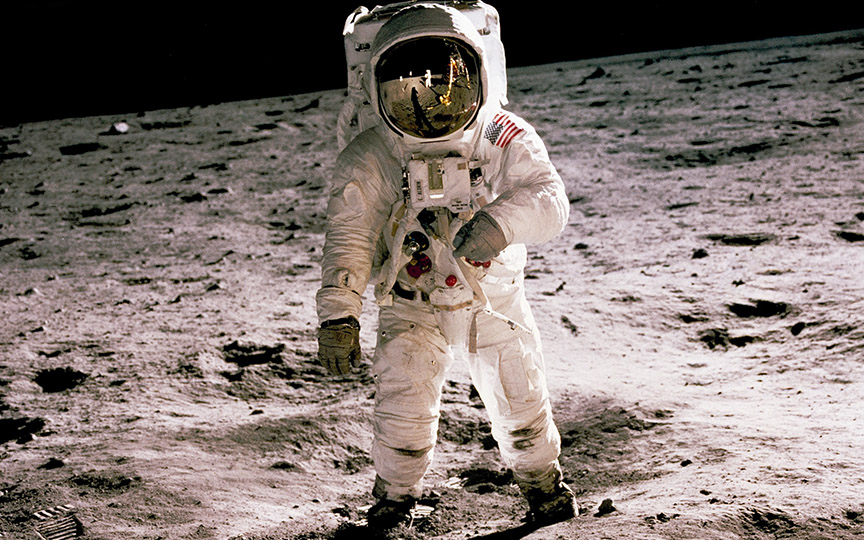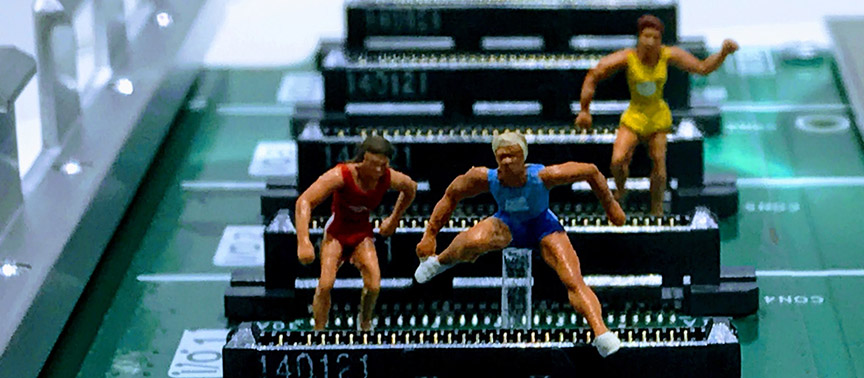Back in 1966, three years prior to the charter date of The Open University (23 April 1969), the spaghetti Western - The Good, The Bad and The Ugly was released. The film grossed over $25million at the box office in North America alone. The relevance of this, well it’s all in the title - 50 years of sports technology has thankfully provided us with a lot of ‘Good’, sorted out some of the ‘Bad’ and, unfortunately, contributed to some of the ‘Ugly’.

It’s hard to know what to cover in such a short space where so much has been invented and integrated into the sports scene, but in true Western style, let’s take aim and shoot for the moon. 50 years ago on July 20th, Neil Armstrong and Buzz Aldrin set foot on the celestial body for the first time. However, to add a sporting connection, it wasn’t until 1971 that the first golf shots were played up there with one ball travelling over a mile!
It’s crazy to think how advanced the technology was for those first expeditions when you consider that tennis players and golfers were still using wooden racquets and drivers respectively, footballs were still made from real leather and athletics had only just graduated from cinder to the all-weather Tartan Track.
This all coincided with the first OU students beginning their studies. Indeed, technology has advanced rapidly both in sport and for the OU. Back in the 70s the TV was part of the furniture and from 1971 was used by the OU to broadcast late night lectures to students. Now it has become part of a home cinema experience in the living room! In the late 70s the popularisation of the video recorder promoted more flexible learning as lectures could be recorded. By the turn of the millennium DVDs were being sent out to students and finally AV material was fully integrated into module materials allowing students to study fully online at their own convenience. Technological ‘Goodness’ was also changing the face of sport.
One of the biggest influences on sporting experiences for both participants and spectators has been the evolution of the Single-Chip Microprocessor. In 1969 the Intel 4004 was invented and was as powerful as any complete computer available at that time. Fast forward 4 years and the first call on a mobile phone was made. As we know, this has developed from a mere telephone to a handheld computer allowing sport to not only be watched in the palm of our hand but also allowing comprehensive analysis, monitoring, management and improvement of our sporting performance, health and physical activity levels.

We can now train and compete with technology incorporated at every level; from a physiological perspective we can monitor heart rates, sleep quality, GPS tracking, muscle activity, recovery etc. From a movement perspective, 1971, saw sports fans introduced to the first slow motion replays. Now of course, we can use 3D motion capture to look at our performance from any angle, assess the forces being created by, and imparted on, our bodies during sport and we can track our training speeds with technology attached to weightlifting bars. Never before have we had access to so much information and data on our performance in sporting activities.

Alongside the development of the computer, the 80s and 90s saw rapid changes in the design of sports equipment. In the early 80s composite tennis racquets shook up the sport by allowing greater spin, ball speeds and shot control, quickly rendering their wooden predecessors obsolete. However, a young John McEnroe delivering the immortal line "you cannot be serious" to Wimbledon umpire Edward James provided enough evidence that further technology was needed to overcome bad line calls. In golf the ‘Big Bertha’ went on sale and converted many golfers from wooden drivers to metal. Finally, from the perspective of the ‘Good’: 2017 saw Nike using technology to invent and test the Vaporfly 4% Elite running shoe, used by the runners in the Nike attempt to break the two-hour marathon barrier, and was reported to increase running efficiency by 4%. Currently this efficiency comes in at a cost of just under £210, and the two-hour barrier still stands.
Overcoming the ‘Bad’: Despite footballing bodies voting in March 2010 to permanently ditch goal-line technology, it was first introduced to matches at the 2012 World Cup in Japan and in the Premier League 2013-14 season. Furthermore, in 2018 Video-Assisted Referees (arriving in The Premier League later this year) were used for first time at the Football World Cup in Russia and won over a lot of critics - it’s certainly technology England could have done with on numerous occasions over the past 50 years, e.g. Maradona’s 1986 ‘Hand of God goal’, not that I am bitter about the late arrival of this technology!
For me, drugs and devolution sit in the sport’s technology ‘Ugly’ category: 1988 conjures up an early memory of the ugliness that can breed from the mix of sport and technology when Ben Johnson was stripped of his Olympic gold medal after a positive drug test. In 2012 Lance Armstrong (7-time Tour de France ‘winner’) was also stripped of his titles due to doping. Drug technology has continued to evolve allowing cheats to stay one step ahead of the testing laboratories for now.
As all technology has advanced it seems that human evolution has taken a turn towards devolution. With the current generation often reported as the first to have a shorter life expectancy than their parents it is unsurprising that physical activity levels in 1969 were 20% higher than they are currently with further predictions stating that by 2030 we will be 35% less active than our 60s relatives (Gov.uk, 2016). Many have blamed these statistics on the distractions and automation that technology brings to our lives, encouraging children to sit and play computer games rather than be out in the streets, or in the garden, climbing, jumping, running and socialising and playing with friends (Slutsky & DeShetler, 2017).

Sport and technology are now so intertwined that with the continuous development of affordable products we will have the means to collect an array of data, some may argue too much that we won’t know what to do with it! However, with so many advances made over the last 50 years only time will tell where technology can now take us as a race, as a University, and how it will continue to contribute to the ‘Good’, overcoming the ‘Bad’ and attempting to eliminate the ‘Ugly’ in sport.










Rate and Review
Rate this article
Review this article
Log into OpenLearn to leave reviews and join in the conversation.
Article reviews